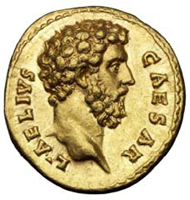September 27, 2012 – Five hundred ancient Greek and Roman coins from the Museum’s world-renowned collection will be showcased in the inaugural exhibition of the MFA’s new coin gallery. Opening September 25, 2012 it is the first gallery dedicated to coins at a major US museum, unique in the world for its emphasis on ancient coins as works of art.
Aureus with the bust of Aelius Verus, Roman, 137 AD.
It is named in recognition of Michael C. Ruettgers, who has given 14 rare and important Roman gold coins to the MFA, including an aureus with the bust of Aelius Verus from 137 AD. The exhibition will draw from the Museum’s collection of approximately 7,500 coins and will feature some of the MFA’s most important Greek and Roman coins, many prized through the centuries as objects of wealth and status.
The dekadrachm (Demareteion) of Syracuse with quadriga (about 465 BC) is the most famous Greek coin in the Museum’s collection and one of the most significant ones in the world, and the tetradrachm of Amphipolis with head of Apollo (390-370 BC) is one of the most sculptural of Greek coin types. They illustrate how Greek coins are highly sophisticated, beautiful works of art on a miniature scale.
The MFA’s Roman coins document political and cultural history, as seen in the denarius with head of M. Junius Brutus (43-42 BC), which warns of death to tyrants on its obverse side with its cap of liberty flanked by two daggers – a coin issued by Brutus in the aftermath of the Ides of March assassination of Julius Caesar. In contrast, the aureus with bust of Claudius II Gothicus (268-270 AD), the largest gold coin in the Museum’s collection, offers a message of stability after a period of turmoil in 3rd-century Rome.
Also on view in the gallery will be complementary works of art to show how coin engravers used the same visual vocabulary and similar compositions as found in larger works, but had to also adapt them to miniature scale and round format. Additionally, the exhibition will examine the influence of ancient coins through the ages as documented by a Frederic II gold coin from the Middle Ages, and an 18th-century American copper coin. To enhance the appreciation of these works, gallery visitors will be able to examine these and other coins on iPads and a computer kiosk.
Visit the really beautiful and inviting site of the Boston MFA.
And you can take a look at the Michael C. Ruettgers Gallery.




